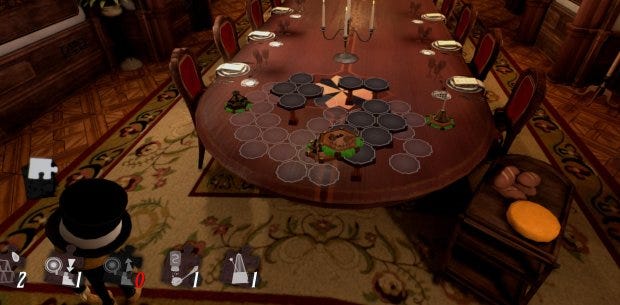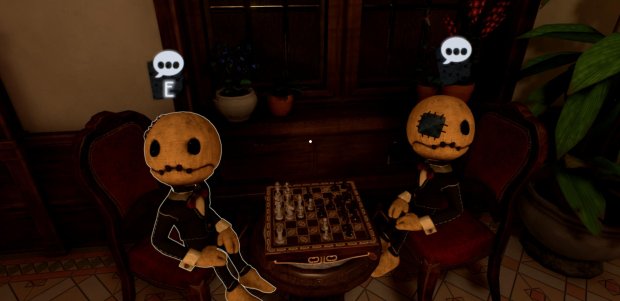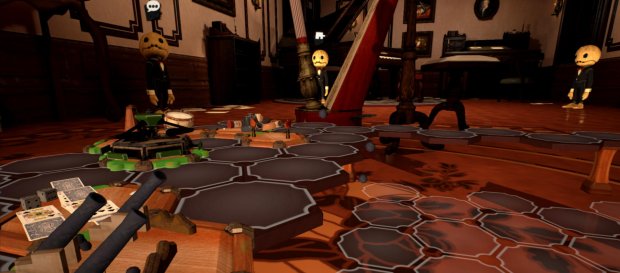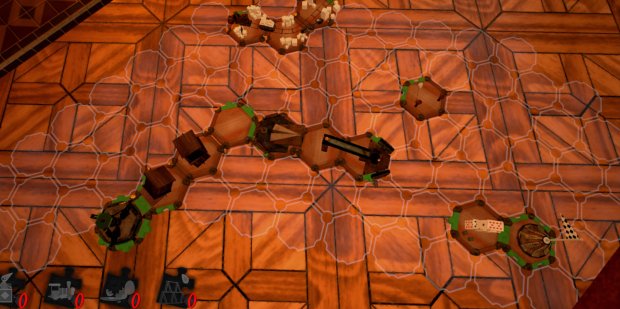Wot I Think: The Automatician
Sackcloth
Hyperbolic responses to you successfully completing a challenge are a perennial issue in puzzle games. When it comes to no-frills mobile puzzling, and for no sensible reason it throws up the word "OUTSTANDING!" at you no matter how tricky the conundrum, it's pleasantly silly. But when a game tries to add an element of narrative to the situation, where characters fall over themselves to bestow you with accolades on clicking through a mundane brain-teaser with little effort. "Astonishing!" they ejaculate after you turn all three lights green or whatmaybe. "You truly are the chosen one! Have my firstborn!" It starts to feel more than a little disingenuous. It is unfortunate that such nonsense runs through the core of The Automatician [official site]. It doesn't help that the main puzzle idea itself just isn't that good.
Oftentimes a narrative is the very last thing a puzzle game needs. A good puzzle is a good puzzle, and rarely can be elevated by having pretend people attempt to justify the existence of the challenges in some narrative form. Tetris, for instance, would not be quite the genre classic it is if between every go we had to watch a cutsence in which the various tetrominos discuss the impending danger from uneliminated horizontal surfaces in the Tetris Kingdom. Of course, I said "rarely", and there are wonderful exceptions like Portal and The Talos Principle. The Automatician falls into neither camp, a game whose setting is definitely its most interesting aspect, but neither the tale nor the puzzles really managing to stand out.
You, a woman called Emma, arrive at a mansion populated by sentient sackcloth figures, who are intent on testing you to fill the recently vacated role of Automatician. These tests take the form of a hexagonal tile-based puzzle in which you must fit bespoke pieces to connect a start and end point to form a linear Rube Goldberg-like chain. It's not nearly as complicated as that sounds - the machine element is completely decorative rather than (sadly) part of how you know to assemble the puzzle. Instead it's really about finding a way to create a path made of the set pieces, each only joining to one another by correctly aligning jigsaw-style inny and outy pieces, on certain edges of each hexagonal end. Which, itself, is fine! It would possibly make for a passable phone game stripped to its barest parts, but is definitely improved by potential embellishments.
Complete a puzzle and you get to see the machine run its course, each piece triggering the next, and with potentially multiple solutions meaning you get a sequence specific to how you assembled things. The big issue here is, it's just done very clumsily. Aside from the pretty crude graphics involved in these sections, it's often unclear how or why one element triggers the next (why should that marble falling there mean a paper aeroplane takes off? etc), meaning instead of what could have been a pleasant visual reward for finishing a puzzle, instead I'm frustrated that it can't be skipped to continue playing.
Rather worse is how the puzzles are displayed. The controls are daft and unchangeable, meaning to scroll outward you have to hold the right mouse button and scroll the wheel, rotate the view with the right mouse button alone, rotate the pieces you're placing with the scroll wheel alone... But really, the only helpful view is a top-down one, and as the puzzles get larger (but seemingly never much more complicated) it sometimes won't let you see the whole play area in shot. And against all sense, in amongst that catastrophe of controls, there's no actual way to just pan about - instead you have to rotate and zoom in awkward ways to try to glimpse the angle you need.
As you play, it quickly becomes apparent that a lot of the sackcloth creatures, called Whodos, aren't big fans of strangers coming in. Their previous Automatician died, and they're still either grieving, or believe themselves self-sufficient in... in... oh boy, I'm pretty sure the game just forgot to say. Or it was so uninvolving that I instantly forgot it myself. Which is a big part of why the lovely effort that's gone into building a little world here feels a touch wasted. It's definitely trying to have an air of mystery as to what happened previously in the mansion, but in doing so forgets to tell you who you, Emma, are, and indeed what it is you've gone there seemingly on purpose to do. Which is a shame, as I'm quite taken by these characters, and I love that occasionally there are bonus puzzles completely different to the tiled jobbies. It just needed to remember that not telling you anything at all isn't the route to developing intrigue, only indifference.
But most egregious is the difficulty, and the response to success. The puzzles aren't hard, and aren't solved by any great leaps of logic or deduction - instead it's just about playing with the pieces until they fit together. Nothing wrong with that, but it becomes a touch silly when the Whodos begin discussing you as the arrival of a new Messiah upon your stumbling through them. "No one has ever managed to get this far!" they declare in wonder bordering on sycophancy, leading me to wonder if anyone else had ever actually tried. "I can see now that your ability to learn and adapt exceeds my own," wails Archie, the Whodo setter of these puzzles, after I realise a solution that doesn't use half of the pieces on offer entirely by mistake.
Which, er, turned out to be the final puzzle in a very short game. A puzzle that was, the story wants me to know, the very most difficult they had, pulling out all the stops, pushing Archie to his very limits - a puzzle no more or less difficult than the second (the first involves placing a single piece). It really is the most peculiar thing. Not just that the puzzles should have been so exceptionally easy to the end while described by the game as post-Mensa levels of hard, but that there would be so few of them. A puzzle format that should, once all the work had been put in to create the pieces, animate the pieces, design the boards, and so on, be relatively straightforward to design for. Since none of the puzzles here gets close to being tricky or require cleverness on the part of the solver, it really ought to have been possible to churn out a few dozen at least to have made the whole endeavour worthwhile. Rather than the paltry eleven on offer.
What an odd thing the result is. It's this framework for what feels like should have been a much better, more entertaining game, and yet the ghost of that potential game leaks through in the charming way it presents the Whodos, and the always welcome environment of a creepy old mansion for setting puzzles. It's too brief, ridiculously easy, and woefully insincere, which certainly renders any recommendable features moot. But I really did like the Whodos.
The Automatician is out now for Windows for £5.60/$8/8€ (with 38% off at time of writing) via Steam.













